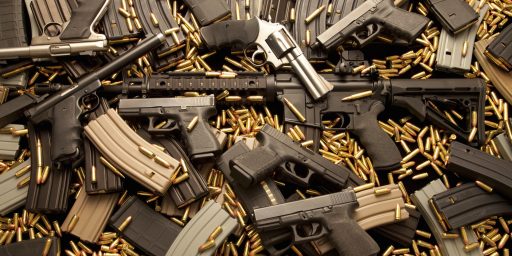LOOSE NUKES
The idea that former Soviet Union weapons technology is for sale to the highest bidder has been talked about for over a decade. As this WaPo piece makes clear, that threat is getting more serious:
In the ethnic conflicts that surrounded the collapse of the Soviet Union, fighters in several countries seized upon an unlikely new weapon: a small, thin rocket known as the Alazan. Originally built for weather experiments, the Alazan rockets were packed with explosives and lobbed into cities. Military records show that at least 38 Alazan warheads were modified to carry radioactive material, effectively creating the world’s first surface-to-surface dirty bomb.
The radioactive warheads are not known to have been used. But now, according to experts and officials, they have disappeared.
The last known repository was here, in a tiny separatist enclave known as Transdniester, which broke away from Moldova 12 years ago. The Transdniester Moldovan Republic is a sliver of land no bigger than Rhode Island located along Moldova’s eastern border with Ukraine. Its government is recognized by no other nation. But its weapons stocks — new, used and modified — have attracted the attention of black-market arms dealers worldwide. And they’re for sale, according to U.S. and Moldovan officials and weapons experts.
When the Soviet army withdrew from this corner of Eastern Europe, the weapons were deposited into an arsenal of stupefying proportions. In fortified bunkers are stored 50,000 tons of aging artillery shells, mines and rockets, enough to fill 2,500 boxcars.
Conventional arms originating in Transdniester have been turning up for years in conflict zones from the Caucasus to Central Africa, evidence of what U.S. officials describe as an invisible pipeline for smuggled goods that runs through Tiraspol to the Black Sea and beyond. Now, governments and terrorism experts fear the same pipeline is carrying nonconventional weapons such as the radioactive Alazan, and that terrorists are starting to tap in.
“For terrorists, this is the best market you could imagine: cheap, efficient and forgotten by the whole world,” said Vladimir Orlov, founding director of the Center for Policy Studies in Moscow, a group that studies proliferation issues.
Why the Alazan warheads were made is unknown. The urgent question — where are they now? — is a matter of grave concern to terrorism and nonproliferation experts who know the damage such devices could do. A dirty bomb is not a nuclear device but a weapon that uses conventional explosives to disperse radioactive materials, which could cause widespread disruption and expose people to dangerous radiation. Unlike other kinds of dirty bombs, this one would come with its own delivery system, and an 8-mile range. A number of terrorist groups, including al Qaeda, have sought to build or buy one.
Lovely.






I wondered for year, but never bumped in to discussion of, the feasibility of us just buying all this crap up. Lord knows we spend a big hunk of coin on defense.
I guess then it is effectively blackmail. And it might send the prices thru the roof. (I dodged the “skyrocketing” pun.) But I wonder what is the current thinking on this?
P
Considering the size of the rocket, the payload would be tiny. These sorts of weapons are properly titled “weapons of mass disruption”–since they have very little potential to kill and just result in a fairly small area of contamination. I’d be much more worried about the SAMs…and without knowing what sort of radiation source is at issue, I’m not overly impressed by the concern expressed by the unidentified “terrorism and nonproliferation experts who know the damage such devices could do”.
And “just buying all this crap up” is not feasible. Even the Russians don’t know how much of this stuff there is, much less where it is or who controls it–so whom would we negotiate with, even if we had piles of money laying around to spend? Remember, the folks selling this stuff are doing it to earn money–and given the relative lack of sophistication of many potential buyers, they can probably get a better price from the ignorants than we’d be willing to meet.
—